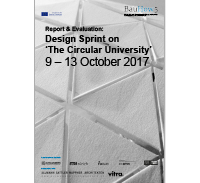Report & Evaluation: Design Sprint on ‘The Circular University’

Initiating a design workshop according to specific methods is interesting in two perspectives. On the one hand, it offers an opportunity to tackle challenges, which have not been in focus so far. On the other hand, it is a testing ground to evaluate fast-track design methods in its applicability and use for architectural education. Today, complex problem-solving requires multidisciplinary collaboration and co-creation. Thus, the question arises, if architectural students are sufficiently prepared for this position and how they would act in processes like these. During the Design Sprint, we want not only to challenge a specific task, but moreover evaluate our hypothesis that architects have the skill set to work effectively in new formats of innovation and create promising outcomes as well as leverage design sprints and other formats.
The “Design Sprint on Circular University” was the first in a series of four workshops, which is embedded in an Erasmus+ Strategic Partnership project, “Strengthening Architecture and Built Environment Research (SABRE)”.
The BauHow5 alliance together with renowned Allmann Sattler Wappner Architekten and Swiss company Vitra invited over 40 students and researchers in architecture and beyond. The challenge was to approach circularity from where we learn to design, and to raise the question of what a ‘Circular University’ would look like in all its possible dimensions? It was an exceptional week of discussions, work and new concepts. It was an insightful week into how fast-track design methods are adapted, what speaks for them, and what does not. And this week was captured in this documentation.
Report & Evaluation: Design Sprint on ‘The Circular University’
Editors: Christos Chantzaras, Martin Luce, Yolande Schneider
Publisher: Technische Universität München, Fakultät für Architektur
ISBN: 978-3-948278-14-4